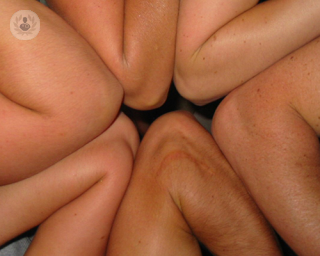What is cubital tunnel syndrome?
Cubital tunnel syndrome (a form of ulnar nerve entrapment or ulnar neuropathy) is a condition in which the ulnar nerve becomes trapped or compressed. This nerve runs from your neck, through the elbow, to your hand, connecting to the little finger and half of the ring finger. It is the largest nerve in the body unprotected by muscle or bone, and due to its relative exposure, it is easy to bump, which may send a strange sensation like an electric shock down your arm (commonly referred to as “hitting your funny bone”). Unfortunately, it is also easy to injure.

There are several places where the ulnar nerve can become trapped and compressed, such as the collarbone and wrist, but the most common place is at the elbow. This is known as cubital tunnel syndrome.
Cubital tunnel may not be as well-known as carpal tunnel, but it is, in fact, the second most common peripheral nerve entrapment syndrome, and can cause the patient severe discomfort.
What are the symptoms of cubital tunnel syndrome?
Cubital tunnel can cause the following symptoms:
- Pain at the elbow
- Numbness in the arm
- A tingling sensation (especially the little and ring fingers)
- Weakness in the fingers (especially the little and ring fingers)
- Decreased ability to grip or pinch the little finger and thumb
- Muscle atrophy in the hand
- A claw-like deformity of the hand

What causes cubital tunnel?
It is often difficult or impossible to pinpoint the exact cause of cases of cubital tunnel syndrome, but there are several things that can put pressure on it:
- Bending your elbow for extended periods, such as on the phone, while sleeping, etc. stretches the ulnar nerve.
- Leaning on your elbow repeatedly or for long periods
- Fluid build-up in the elbow
- Abnormal bone growth in the elbow
- Intense physical activity affecting the ulnar nerve, e.g. cricket bowlers
- Hitting the funny bone can cause pain and tingling (but this is usually temporary)
Prior fractures and dislocations, arthritis, swellings, and cysts around the elbow can all also be risk factors.
What is the treatment for cubital tunnel syndrome?
Cubital tunnel can often be managed conservatively, with physical therapies, such as:
- Wearing a splint while asleep to help keep the elbow straight
- Wearing protective padding over the elbow during daily activity
- Generally avoiding undue pressure – don’t lean your elbow on an open window while driving, or when using a computer, don’t rest your elbows on the desk, etc.
In some cases, if the pressure on the nerve does not release via other methods, surgery may be required. There are different operations available, ranging from simply releasing the source of the pressure to decompress the ulnar nerve to shifting the nerve within the elbow. Most patients respond to surgical intervention, though it is usually a last resort. Full recovery of hand and wrist strength can take several months, and physical rehabilitation may be necessary.
As with any treatment, the medical specialist will discuss and decide the best course of action for each individual case.
Cubital tunnel syndrome
Professor Paul Lee - Orthopaedic surgery
Created on: 05-03-2018
Updated on: 10-18-2023
Edited by: Sophie Kennedy
What is cubital tunnel syndrome?
Cubital tunnel syndrome (a form of ulnar nerve entrapment or ulnar neuropathy) is a condition in which the ulnar nerve becomes trapped or compressed. This nerve runs from your neck, through the elbow, to your hand, connecting to the little finger and half of the ring finger. It is the largest nerve in the body unprotected by muscle or bone, and due to its relative exposure, it is easy to bump, which may send a strange sensation like an electric shock down your arm (commonly referred to as “hitting your funny bone”). Unfortunately, it is also easy to injure.

There are several places where the ulnar nerve can become trapped and compressed, such as the collarbone and wrist, but the most common place is at the elbow. This is known as cubital tunnel syndrome.
Cubital tunnel may not be as well-known as carpal tunnel, but it is, in fact, the second most common peripheral nerve entrapment syndrome, and can cause the patient severe discomfort.
What are the symptoms of cubital tunnel syndrome?
Cubital tunnel can cause the following symptoms:
- Pain at the elbow
- Numbness in the arm
- A tingling sensation (especially the little and ring fingers)
- Weakness in the fingers (especially the little and ring fingers)
- Decreased ability to grip or pinch the little finger and thumb
- Muscle atrophy in the hand
- A claw-like deformity of the hand

What causes cubital tunnel?
It is often difficult or impossible to pinpoint the exact cause of cases of cubital tunnel syndrome, but there are several things that can put pressure on it:
- Bending your elbow for extended periods, such as on the phone, while sleeping, etc. stretches the ulnar nerve.
- Leaning on your elbow repeatedly or for long periods
- Fluid build-up in the elbow
- Abnormal bone growth in the elbow
- Intense physical activity affecting the ulnar nerve, e.g. cricket bowlers
- Hitting the funny bone can cause pain and tingling (but this is usually temporary)
Prior fractures and dislocations, arthritis, swellings, and cysts around the elbow can all also be risk factors.
What is the treatment for cubital tunnel syndrome?
Cubital tunnel can often be managed conservatively, with physical therapies, such as:
- Wearing a splint while asleep to help keep the elbow straight
- Wearing protective padding over the elbow during daily activity
- Generally avoiding undue pressure – don’t lean your elbow on an open window while driving, or when using a computer, don’t rest your elbows on the desk, etc.
In some cases, if the pressure on the nerve does not release via other methods, surgery may be required. There are different operations available, ranging from simply releasing the source of the pressure to decompress the ulnar nerve to shifting the nerve within the elbow. Most patients respond to surgical intervention, though it is usually a last resort. Full recovery of hand and wrist strength can take several months, and physical rehabilitation may be necessary.
As with any treatment, the medical specialist will discuss and decide the best course of action for each individual case.


Cubital tunnel release surgery: what to expect
By Mr Phil Wright
2025-01-28
Fed up of feeling pins and needles in your arm when you're trying to sleep at night? Then the surgical procedure cubital tunnel release may be an option for you. Here, one of our leading orthopaedic surgeons Mr Phil Wright explains everything you need to know about the surgery, which relieves the compressed ulnar never in your elbow. See more


Is it cubital tunnel (carpal tunnel elbow) or carpal tunnel syndrome?
By Mr Nick Ferran
2025-01-28
It's more likely that you've heard of carpal tunnel syndrome, a trapped nerve in the wrist, over cubital tunnel syndrome, where the ulnar nerve is compressed in the elbow. Expert orthopaedic surgeon Mr Nick Ferran explains the symptoms of both and whether it's possible to have the two conditions at the same time. See more


How do I know if I need elbow surgery?
By Mr Nick Ferran
2025-01-28
Most chronic elbow conditions can be helped with non-surgical management such as physiotherapy. However, some conditions continue to cause pain or stiffness despite physiotherapy and may require surgery. We asked orthopaedic surgeon Mr Nick Ferran about shoulder surgery and how to take care of your elbow afterwards. See more


Cubital tunnel syndrome: all you need to know
By Professor Mohamed Imam
2025-01-28
Cubital tunnel syndrome is a condition that can affect the elbow and can occur quite frequently if we bang our elbow off firm objects. Here to talk us through the condition in more detail is experienced consultant orthopaedic surgeon, Professor Mohamed Imam. See more
Experts in Cubital tunnel syndrome
-
Mr Nick Ferran
Orthopaedic surgeryExpert in:
- Shoulder arthroscopy
- Elbow Pain
- Frozen shoulder
- Rotator cuff surgery
- Cubital tunnel syndrome
- Shoulder surgery
-
Mr Ravi Badge
Orthopaedic surgeryExpert in:
- Carpal tunnel syndrome
- Cubital tunnel syndrome
- Trigger finger
- Thumb Osteoarthritis
- Epicondylitis (tennis elbow)
- Rotator cuff injury
-
Mr Ritesh Sharma
Orthopaedic surgeryExpert in:
- Carpal tunnel syndrome
- Cubital tunnel syndrome
- Hand arthritis
- Dupuytren’s contracture
- Trigger finger
- Wrist surgery
-
Mr Tim Halsey
Orthopaedic surgeryExpert in:
- Carpal tunnel surgery
- Dupuytren’s contracture
- Arthroscopic debridement
- Cubital tunnel syndrome
- Hand arthritis
- Hand tendonitis
-
Mr Ramesh Jayarama Rao Chennagiri
Orthopaedic surgeryExpert in:
- Carpal tunnel syndrome
- Trigger finger
- Ganglion cyst
- Dupuytren’s contracture
- Thumb arthritis
- Cubital tunnel syndrome
- See all

New Victoria Hospital
New Victoria Hospital
184 Coombe Lane West, Kingston upon Thames, KT2 7EG
No existe teléfono en el centro.
By using the telephone number provided by TOP DOCTORS, you automatically agree to let us use your phone number for statistical and commercial purposes. For further information, read our Privacy Policy
Top Doctors

The Clementine Churchill Hospital - part of Circle Health Group
The Clementine Churchill Hospital - part of Circle Health Group
Sudbury Hill, Harrow HA1 3RX
No existe teléfono en el centro.
By using the telephone number provided by TOP DOCTORS, you automatically agree to let us use your phone number for statistical and commercial purposes. For further information, read our Privacy Policy
Top Doctors

Sheffield Orthopaedics Ltd
Sheffield Orthopaedics Ltd
Claremont Hospital, 401 Sandygate Rd, Sheffield
No existe teléfono en el centro.
By using the telephone number provided by TOP DOCTORS, you automatically agree to let us use your phone number for statistical and commercial purposes. For further information, read our Privacy Policy
Top Doctors
-
New Victoria Hospital
184 Coombe Lane West, Kingston upon Thames, KT2 7EG, South LondonExpert in:
- Cardiology
- General Surgery
- Orthopaedic surgery
- Breast augmentation
- Pain management
- Spine
-
The Clementine Churchill Hospital - part of Circle Health Group
Sudbury Hill, Harrow HA1 3RX, West LondonExpert in:
- Abdominal ultrasound
- Abdominoplasty
- Acne
- Allergies bronchopulmonary
- Allergies nose and ears
- Allergy Dermatitis
-
Sheffield Orthopaedics Ltd
Claremont Hospital, 401 Sandygate Rd, Sheffield, SheffieldExpert in:
- Hip
- Orthopaedic surgery
- Orthopaedic spinal surgery
- Shoulder and elbow
- Joint replacement
- See all
- Most viewed diseases, medical tests, and treatments
- Osteoporosis
- Ulnar nerve entrapment
- Peripheral nerve block
- Peripheral neuropathy
- Joint pain
- Lumbar herniated disc
- Spinal surgery
- Minimal access surgery (keyhole surgery)
- Shoulder pain
- Botulinum toxin (Botox™)








